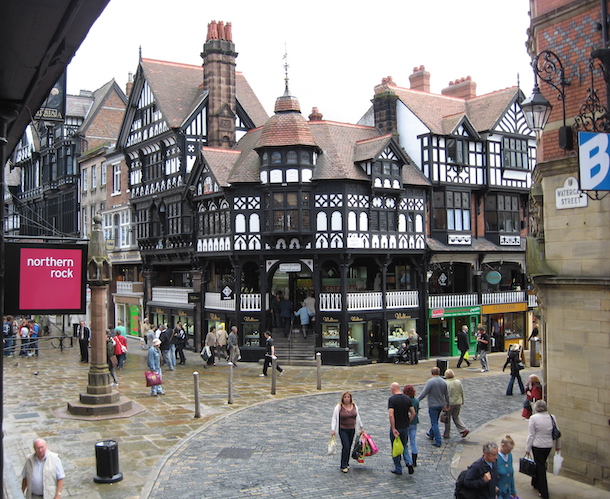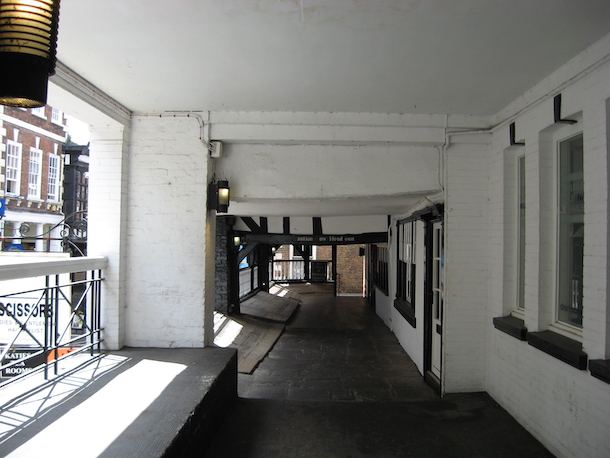Chester's Rows
Perhaps one of the
most distinctive architectural features of Chester are the Rows. These
two-tiered medieval galleries are now home to some of the best shops in
the city.
The Rows are a unique system of covered walkways with shops and
commercial properties on two levels. They are open to the street on one
side and the levels can be reached from stairs at ground level. Records show that the Rows have existed at least since the late 13th
century. How they came to be built is not known for sure, but a
devastating fire in 1278 and subsequent attempts at town planning could
account for their origins. However, archaeological
excavations have so far found no evidence for this fire and there is no
real evidence that re-building was deliberately 'planned' to include a
Row system. The first documentary references to Rows, relate to the area
around St. Peter's Church in the commercial heart of the city. By the
1290s, the area on the east side of Northgate Street was known as
Ironmonger's Row and houses with undercrofts are recorded. These early
Row buildings probably had an elevated gallery, but were not yet part of
a continuous system. Access to Row level would have been by many
different flights of steps. However, during the 14th century galleries
were gradually linked to form continuous walkways, possibly through the
co-operation of adjacent property owners who needed to make their
premises more accessible. The splendid black and white half-timbered buildings of The Rows which are
now visible may have existed since Medieval times but have been rebuilt and renovated
over time and a closer look reveals that most of the current buildings
are in fact of Victorian or even Edwardian design. A Scandinavian link has also been suggested, as there was a known
Scandinavian presence in the city in the 9th and 11th centuries. The Rows are found on four main streets in the city - Bridge Street,
Watergate Street, Eastgate Street and part of Northgate Street. During
the Civil War, Chester suffered a disastrous siege from November 1644
until February 1646, when it was starved into surrender. The city was
very badly damaged and the economy was in tatters. Rebuilding took many
years, continuing well into the 1660s. Timber was still the favoured
material, although brick was now in use in other parts of Cheshire.
However, towards the end of the 17th century, Chester's prosperity
revived and the city became a fashionable social centre. Landed families
began to rebuild their old town houses in the latest classical styles.
Wherever possible they sought to get rid of the Row, which was both
architecturally unfashionable and an intrusion on their privacy. During
the late 17th century and 18th centuries, significant sections of the
ancient Rows system was lost through enclosure or rebuilding. The earliest recorded enclosure of a Row was during the Civil War in 1643, when Sir Richard Grosvenor
petitioned the Assembly to enclose the Row of his town house in Lower
Bridge Street (now the Falcon), in order to enlarge the building. As a
leading Royalist commander, garrisoned at Chester Castle, his request
was granted and the Row walkway was enclosed to form a new room in the
front of the house. The stone columns which once supported the upper
floor and the original shop front at Row level, can still be seen in the
Falcon bar. The grant to Richard Grosvenor set a precedent which was to lead to the loss of almost all
the Rows in Lower Bridge Street. Because of the turmoil of Civil War, it
was not until 1668 that the next permission to enclose was sought and
granted. Once a section of Row has been lost, householders were able to
claim that it was now useless as a public walkway. In 1676, Lady Mary
Calvely petitioned to enclose a Row so that she could build an entirely
new mansion - Bridge House (now Oddfellows Hall) was envisaged to be
"a grace and ornament to the city". In 1699, the lawyer John
Mather also gained permission to build a major new house, resulting in
the loss of the Row at 51 Lower Bridge Street. Not all property owners
had the wealth to completely rebuild, many simply re-fronted their
houses, absorbing the Row as an additional room. The Row of Tudor House,
enclosed by Roger Ormes in 1728, still survives within the building. The Rows of Lower Bridge Street were sacrificed to architectural fashion because they had become
predominantly domestic rather than commercial. Elsewhere, in the heart
of the city, the Rows were still thriving places of trade and the
Assembly exerted control by refusing permissions to enclose. Sir George Booth who rebuilt two medieval houses in Watergate
Street in 1700, was obliged to keep the Row walkway, ingeniously
creating the best classical mansion in the Rows. However, Row enclosure
can be traced in all four main streets, with the sections of Row
furthest from the commercial heart of the city generally being lost. The rows have secondary names which derive from the traders who carried on their
business there (Shoemakers´ Row, Ironmongers´ Row, etc). Today they
mostly house a variety of small shops, bars and restaurants, although
there are still some private houses on the Rows. In some places the Rows
have been "enclosed", that is the Row has been blocked-off at
both sides and the space has been incorporated into a building. Often,
as in Lower Bridge Street, the internal layout of these buildings
reflect the fact that the Row once passed through them - a particular
example is the Old Kings Head another is the Falcon. Several of the shops at street level on the Rows have medieval stone
cellars or crypts. Although some of them have been radically altered, a
few remain and are worth a visit.




